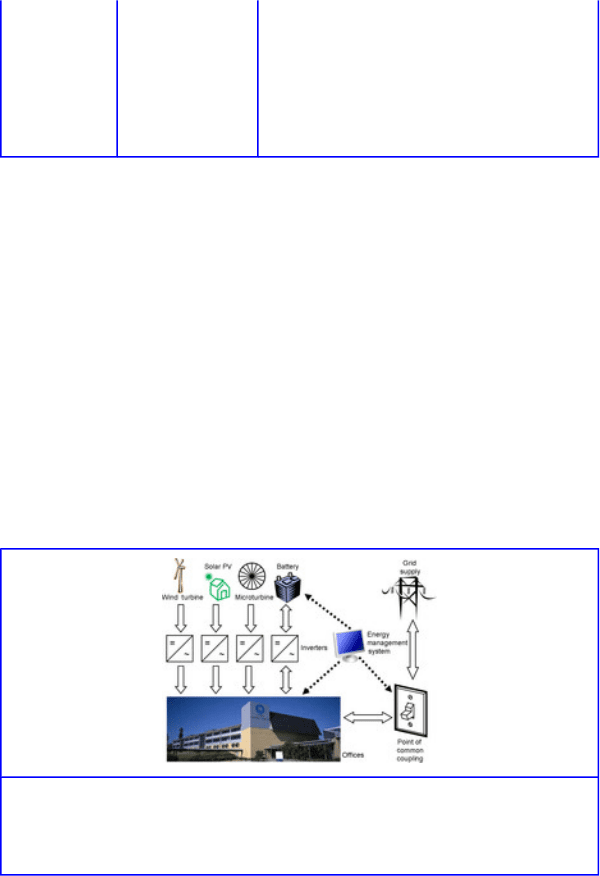Sioshansi F.P. Smart Grid: Integrating Renewable, Distributed & Efficient Energy
Подождите немного. Документ загружается.


Resilient
Able to reconfigure to withstand device failure and avoid total system
collapse. Able to maintain quality of supply despite issues on the wider
electricity grid.
Dynamic
Constantly changing in order to meet the intelligent and resilient goals
above.
Load
Integrated
Includes intelligent integration of local loads with generation,
matching supply and demand and maximizing infrastructure
utilization.
Flexible
Facilitates easy introduction of new loads and generators and the
adoption of new communications technologies, without requiring
significant infrastructure change.
Table 8.2
What a Microgrid Is Not
Commonly
Used Name
Typical Example Why This Is Not a Microgrid
Remote area
power supply
A remote
community
supplied by a
small number of
relatively large
(100 kW+)
generators
There are only a small number of generators,
with a centralized control system linking
them. Any dynamic control is typically
limited to throttling the generator, and no load
control is incorporated. Such systems do not
exhibit the underlying challenges found in
multiple small-generator microgrids.
Local
renewable
energy system
A single house or
building with a
local renewable
energy system (for
instance, a wind or
solar generator).
May be grid
connected
Typically such systems operate using a DC
bus and single inverter, so do not fit into our
definition of a microgrid having multiple AC
sources. Further, the loads and generators in
such a system rarely exhibit any form of
intelligent, dynamic control.
Local backup
power supply
A single house or
building with a
local backup
power supply
(such as batteries
or a fossil-fuel
generator)
Typically such systems operate using a single
generation source or battery supply, so do not
fit into our definition of a microgrid having
multiple AC sources.
Grid-connected
peaking plant
Relatively large
(>1 MW)
Connected to an inter-meshed distribution
system, these have multiple points of
421

generators
interspersed
throughout a
distribution
network for
meeting peak
demand
connection to the wider grid, violating our
definition that a microgrid has one single
point of connection. Such a topology
demonstrates different electrical
characteristics from a microgrid with only a
small number of electrical busses.
Figure 8.2 shows an example of a connected microgrid
system deployed at an industrial campus. Power is obtained
from the grid to supply loads, in this case the offices, as on a
conventional site, but can also be obtained from the
embedded generation, including wind turbines, solar
photovoltaic panels, and a microturbine. All of these feed
power to the site via inverters. The battery is equipped with a
two-way power inverter that can absorb power when excess is
available or supply power when there is a shortage. If
embedded generation is greater than the required load, excess
power can be exported to the grid via the two-way point of
common coupling (PCC).
Figure 8.2
Simplified diagram of a commercial microgrid.
The site detailed in Figure 8.2 can be also isolated from the
grid at the PCC, in which case the loads are supplied from the
422
embedded generation only. In this case, the microgrid control
system must carefully control which loads are allowed to
draw power, in order to balance supply with demand.
Fluctuations in the renewable generation due to changing
weather conditions are balanced by judicious charging and
discharging of the batteries, under the control of the microgrid
control system. Some of the key features of the microgrid
shown in Figure 8.2 that set it, and microgrids in general,
apart from more traditional power distribution systems are:
• The use of distributed generation sources, including
renewable and combined heat and power (CHP) generators;
• The introduction of dynamic load control systems;
• The use of multiple grid-connected inverters;
• The ability to island the system; and
• A point of common connection (for connected
microgrids).
These features, while they may occur in isolation in
traditional electricity systems, combine to form a unique set
of opportunities and hurdles when deployed as a microgrid.
Key Technologies
To fully realize the benefits possible from a sophisticated
microgrid, as opposed to the relatively simple systems
described in Table 8.2, a number of key technologies are
required. On the generation side, a diverse range of
generation types is particularly useful, allowing the microgrid
to take advantage of the different availability characteristics
of particular generation sources such as solar, wind, or fuel
generators. On the demand side, controllable loads, typically
with some discretionary ability in when they need to be
423
activated, allow the microgrid to flexibly schedule demand to
match generation. Lastly, some form of energy storage, either
electrical, such as batteries or flywheels, or thermal, such as
heat retained in an air-conditioned building's walls, is useful
to aid the balancing of supply and demand. Finally, a
sophisticated sensing, communications, and control system is
needed to link all these microgrid assets together. Key
characteristics of this system should include:
• Advanced high-speed control methods are needed to
maintain microgrid stability and provide intelligent and
dynamic operation, despite having no central point of grid
“inertia”[3] and [4].
• Advanced sensing, diagnostics, forecasting, and
adaptation technologies are needed to provide the
microgrid control system with detailed and up-to-date
information on the status of the microgrid [4] and [5]. Care
must be taken to ensure that a minimum number of sensors
are used and that the total capital outlay is also minimized.
• Integrated communications systems link the various
resources in the microgrid to ensure reliable operation,
even during typical communication outages [5].
• Advanced materials to provide economic,
high-performance energy storage devices, such as batteries
or flywheel technologies, will facilitate microgrids of
growing complexity and size.
The Advantages of Microgrids
While the previous sections suggest microgrids as a natural
path in the evolution of the wider electricity system, there are
also a number of discrete benefits for owners and operators of
microgrids.
424

Autonomy of Supply
By operating their own network of local generators and
coordinated loads, a microgrid owner/operator need no longer
be reliant on the wider electricity grid. In maintaining the
ability to island from the wider grid, a microgrid can ensure
robust and reliable supply for its enclosed loads, isolated from
faults on the wider electricity system. The microgrid can also
provide enhanced power quality compared to the wider grid,
useful in critical applications such as semiconductor
manufacture. The Palmdale Water Treatment Plant microgrid
in the United States [6] and CSIRO Energy Technology
microgrid in Australia [7] are examples of microgrids
operating with a grid connection, but in being able to operate
in islanded mode, they are able to ensure the maintenance of
local supply during time of macro grid failure.
Coordination of Distributed Generation
As the penetration of distributed generators in traditional
(non-microgrid) electricity systems increases, the types of
challenges described earlier grow in concern. Microgrids
present a way of addressing these challenges—by
coordinating geographically proximate generators, a
microgrid can avoid the challenging interactions that
conventional distributed generators display when attached
directly to the wider grid. Microgrids do this in a way that
does not require a large, capital-intensive, and technically
challenging centralized control system, facilitating greater
penetration of distributed generation without many of the
limiting challenges. Many of the microgrids referred to in
section “Existing Installations with Microgrid Features” of
425

this chapter include a plurality of generation types, and,
particularly in the research microgrids, there is a great deal of
work investigating the benefits available from better
coordination of these various generators.
Aggregation of Resources
Connected microgrids, with their single point of connection to
the wider electricity system, implicitly aggregate all the
resources within the microgrid to appear as one large, single
controllable resource. This resource may appear to shed load,
where this outcome could occur by increasing local
generation within the microgrid; or by shedding controllable
load, it could absorb controllable amounts of power by
ramping up loads/reducing local generation, or it could
provide system support through reactive power control. This
single large resource provided by the microgrid has greater
flexibility, reliability, sophistication of control, and less
infrastructure requirements than significantly less
sophisticated mechanisms such as direct load control systems,
which shed load through (for example) air-conditioner
management. The Kythnos [8] and CSIRO [7] microgrids are
real-world examples of where multiple generators, as well as
loads, are being aggregated and managed through local
microgrid control schemes, thus removing the complexity of
controlling large numbers of small generators from the macro
grid operator.
High Penetration of Renewable Supply
The traditional view of electrifying remote areas was that
while some renewable sources could be included, a large
426

centralized fossil-fueled generator was needed to provide
“spinning reserve” and act as inertia for the generation
system. Microgrids challenge this theory, being designed
around multiple small generators, without any single large
source of inertia. With appropriate control and management
mechanisms, microgrids can allow high penetration of
renewable resources in powering remote communities,
without needing the fossil-fueled generators. Many of the
microgrids described in Table 8.3 are operating with greater
than 50% of the electrical load being met by renewable
generation supply.
Table 8.3
Some Microgrid Installations from Around th
Name Location Research/Features Capacity Storage
Fuel
Cells
Reciprocatin
engines
Cape Verde
wind-diesel
systems
Cape Verde
Islands,
Africa
A collection of
remote islands with
wind-diesel
systems; wind
penetration levels
between 14% and
6%.
Between 4
MW and 12
MW
reciprocating
engine and
600 kW and
900 kW
wind
Unknown x
CICLOPS
microgrid
Soria, Spain
Designed for
experimentation;
not strictly a
microgrid as the
three sources are
coupled to a single
common DC bus.
20 kVA
reciprocating
engine 595
Ah battery 5
kW solar 7.5
kW wind
Battery x
Coyaique
Power
System
Coyaique,
Chile
Isolated
community;
manually operated
control.
16.9 MW
reciprocating
engine 4.6
MW hydro 2
MW wind
Unknown x
427

CSIRO
Energy
Technology
Centre
microgrid
Newcastle,
New South
Wales,
Australia
Real-world system
designed to also
operate as an
experimental
facility; allows
islanding, import
and export of
power.
110 kW PV
60 kW wind
150 kW
turbines
Three kinds of
battery; fourth
type planned.
Fernando de
Noronha
island
Fernando de
Noronha,
Brazil
Isolated microgrid
servicing
approximately
2,500 people;
aiming for 25%
wind penetration.
2 MW
reciprocating
engine 225
kW wind
Unknown x
Flores
Island
microgrid
system
Flores Island,
Azores,
Portugal
Studies have
investigated impact
of penetration levels
on system stability;
achieved >50%
wind penetration.
600 kW
reciprocating
engine 1.48
MW hydro
600 kW
wind
Unknown x
Herbec
Plastics
Ontario, New
York, USA
Provides 100% of
energy needs for the
site.
750 kW
turbine 250
kW wind
Unknown
Kings
Canyon
microgrid
Kings
Canyon,
Northern
Territory,
Australia
Supplies a tourist
park; features
computer-controlled
energy
management.
225 kW
solar 650
kW
reciprocating
engine
(approx)
Unknown x
Kythnos
microgrid
Kythnos
Island,
Greece
One of the first
microgrids in the
world (operational
since 2003);
services a remote
community; no
utility grid
connection.
12 kW PV
85 kWh
battery 5 kW
reciprocating
engine
Battery x
Lolland
microgrid
Island of
Lolland,
Denmark
Using CHP;
services 10 homes;
uses small
methane-burning
turbine.
11 MW
wind 15 kW
turbine
Hydrogen x
428

Miquelon
Wind-Diesel
Project
Miquelon,
Canada
Between 20% and
35% wind
penetration;
integrates wind into
a pre-existing diesel
grid.
5.2 MW
diesel 600
kW wind
Battery x
NTT
Facilities’
Tohoku
Fukushi
University
microgrid
Tohoku
Fukushi
University,
Sendai,
Japan
Services five
university
buildings, an aged
care facility, high
school, and water
treatment plant;
uses AC and
high-voltage DC;
connected to utility
grid.
50 kW PV
250 KW fuel
cell 700 kW
reciprocating
engine 800
kVA battery
Battery x x
Palmdale
Water
Treatment
Plant
California,
USA
Plans to allow
island mode;
storage will be used
for blackout
support; will offer
ancillary services.
950 kW
wind 1350
kW
reciprocating
engine 250
kW hydro
Ultra-capacitor x
Sandia
National
Laboratories
(SNL)
research and
the
Distributed
Energy
Technology
Lab (DETL)
Albuquerque,
New Mexico,
USA
Storage, islanding
testing, and
scheduling of PV
and wind studies.
Battery,
flywheel, and
supercon-ductors
x x
Subax
residential
microgrid
Subax,
Xinjiang,
China
Services 60 homes;
appears to be an
isolated microgrid.
30 kW
reciprocating
engine 4 kW
solar 16 kW
wind
Battery x
Utsira
microgrid
Island of
Utsira,
Norway
Research and
development
project; fully
autonomous; linked
to mainland by sea
1.2 MW
wind 50
kWh battery
5 kWh
flywheel 48
Battery,
flywheel, and
hydrogen
x x
429

cable; services 10
homes.
kWh
electrolyser
10 kW fuel
cell 55 kW
reciprocating
engine
The Challenges for Microgrid Adoption
Though the microgrid concept is powerful and carries with it
numerous advantages from both an economic and
environmental perspective, it is unrealistic to assume that the
construction of a full-scale system will be without significant
challenges. These challenges come from the intersection of
new technologies, emerging standards, dated regulations, and
practical goals, and are introduced in the following sections.
Control of Microgrids
Control of microgrids is one of the most frequently cited
issues facing this technology. Control in this context refers to
the scheme and apparatus for ensuring that various parameters
of the microgrid lie within limits that will guarantee the
desired behavior of the system, including the effects of the
microgrid upon the wider grid and the safety of personnel.
Taken as a whole, the task of controlling multiple distributed
sources and loads across a microgrid to achieve stability is
highly complex. While traditional centralized control
approaches are generally used in a microgrid, the complexity
of algorithms required for centralized control of a growing
and more dynamic distribution system, and the
communications bandwidth required to support that control,
has led to suggestions that a measure of decentralization
could ameliorate this burden. With this in mind, newer
430
